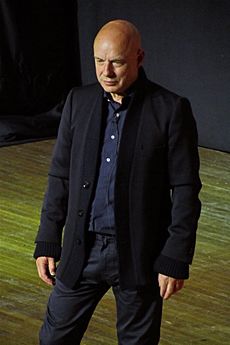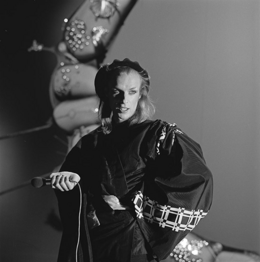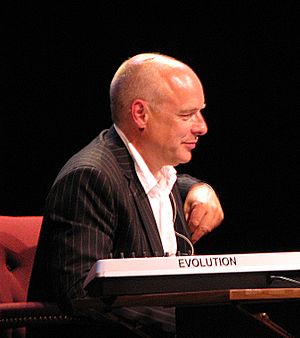Brian Eno facts for kids
Quick facts for kids
Brian Eno
RDI
|
|
|---|---|

Eno in 2015
|
|
| Born |
Brian Peter George Eno
15 May 1948 Melton, Suffolk, England
|
| Other names |
|
| Occupation |
|
| Years active | 1970–present |
| Spouse(s) |
Sarah Grenville
(m. 1967, divorced)Anthea Norman-Taylor
(m. 1988) |
| Children | 3 |
| Relatives | Roger Eno (brother) |
| Musical career | |
| Genres |
|
| Instruments |
|
| Labels |
|
| Signature | |
 |
|
Brian Eno (born May 15, 1948) is an English musician, songwriter, and record producer. He is also a visual artist and activist. Eno is famous for helping to create and popularize ambient music and electronic music. He has also produced many rock and pop albums.
Eno calls himself a "non-musician" because he often uses unusual ways to make music. He is known as one of the most important and creative people in popular music. In 2019, he became part of the Rock and Roll Hall of Fame as a member of the band Roxy Music.
Born in Suffolk, England, Eno studied art and experimental music in the mid-1960s. He joined the glam rock band Roxy Music in 1971 as their synthesizer player. After recording two albums with them, he left in 1973. He then started releasing his own music. His album Ambient 1: Music for Airports (1978) even gave a name to the "ambient music" style.
Besides his solo work, Eno has worked with many other musicians. These include David Bowie, Talking Heads, and U2. He also creates sound installations, makes films, and writes. Eno helped create Oblique Strategies, a set of cards with ideas to help people think creatively. He is also involved in humanitarian causes and is a founding member of the Long Now Foundation.
Contents
Early Life & Education
Brian Peter George Eno was born on May 15, 1948, in Melton, Suffolk, England. His father, William Arnold Eno, worked for the postal service and repaired clocks. His mother, Maria Alphonsine, was from Belgium. Brian was the oldest of three children. His brother, Roger Eno, is also a musician.
In 1959, Eno went to St Joseph's College in Ipswich. During this time, he started listening to American R&B, blues, and doo-wop music. He was also inspired by the Dutch painter Piet Mondrian.
By 1964, Eno was very interested in art and music. He decided not to pursue a "normal job." He enrolled at the Ipswich School of Art. One of his teachers, Tom Phillips, became a lifelong friend and encouraged his music. In 1966, Eno studied Fine Arts at the Winchester School of Art, graduating in 1969. At Winchester, he heard Pete Townshend of The Who speak. This made Eno realize he could make music without formal training.
While in school, Eno used a tape recorder as a musical instrument. In 1964, he joined his first band, the Black Aces. Later, in 1967, he formed an avant-garde music trio called the Merchant Taylor's Simultaneous Cabinet. He also played in other experimental groups.
Music Career Highlights
Starting in the 1970s
In 1969, Eno moved to London and began his professional music career. He joined experimental groups like the Scratch Orchestra and the Portsmouth Sinfonia. His first commercial recording was with the Scratch Orchestra in 1971.
In 1971, Eno helped form the glam rock band Roxy Music. He met saxophonist Andy Mackay by chance at a train station. Eno played on their first two albums, Roxy Music (1972) and For Your Pleasure (1973). He was known for playing the synthesizer, adding tape effects, and singing backup. On stage, he became famous for his flashy costumes and makeup. Eno left the band in 1973 due to disagreements with the lead singer, Bryan Ferry.
Soon after leaving Roxy Music, Eno started his solo career. In 1973, he released ..., a collaboration with Robert Fripp. This album used tape looping and delay systems, which became known as "frippertronics." It was seen as very important for future experimental and ambient music. They released a second album, Evening Star (1975).
Eno's first solo album, Here Come the Warm Jets, came out in 1974. It was praised by critics. In March 1974, he released the single "Seven Deadly Finns," which was his only top 40 hit in the UK. His second solo album, Taking Tiger Mountain (By Strategy), was released in November 1974. It featured musicians like Phil Collins and Robert Wyatt. The song "Third Uncle" from this album became one of his most famous rock songs.
In 1975, Eno was hit by a taxi and had to rest at home. During this time, a friend brought him a record of harp music. He listened to it very quietly, and this experience inspired him. He then recorded Another Green World, released in November 1975. This album had many instrumental tracks and was seen as a "masterpiece."
Later in 1975, Eno released Discreet Music, a minimalist electronic album. It is considered a key album in the ambient music genre. This album led to his collaboration with David Bowie on Bowie's "Berlin Trilogy" albums.
In 1978, Eno released Ambient 1: Music for Airports, which officially introduced the term "ambient music." He wrote that ambient music should be "as ignorable as it is interesting," meaning it can be listened to closely or just be part of the background.
1980s and Beyond
In the early 1980s, Eno worked with David Byrne of Talking Heads. Their album My Life in the Bush of Ghosts (1981) used sampled sounds from radio broadcasts and world music.
In 1983, Eno collaborated with his brother, Roger Eno, and Daniel Lanois on Apollo: Atmospheres and Soundtracks. This album was made for a film about space.
In the 1990s, Eno started working with "generative music." This is music that creates itself using computer systems, so it never sounds exactly the same twice. He used this idea in his art and sound installations. He also produced albums for the band James and collaborated with U2 and Luciano Pavarotti on the album Original Soundtracks 1 as part of a group called Passengers.
In 2004, Eno and Robert Fripp released another ambient album, The Equatorial Stars. In 2005, Eno released Another Day on Earth, which featured his vocals more prominently. In 2006, he released 77 Million Paintings, a computer program that creates endless combinations of video and music for home computers.

In 2008, Eno worked with David Byrne again on Everything That Happens Will Happen Today. He also designed the sound for the video game Spore. In 2009, Eno performed live for the first time in many years at the Luminous Festival in Sydney.
In the 2010s, Eno continued to release solo albums like Small Craft on a Milk Sea (2010) and Lux (2012). He also collaborated with artists like Damon Albarn and Karl Hyde. In 2016, he released The Ship, an album with music from his art installation. His generative music album Reflection was released in 2017 and was nominated for a Grammy Award.

In March 2020, Eno and his brother, Roger Eno, released their album Mixing Colours. In October 2022, he released Foreverandevernomore, an album mostly featuring his voice. In May 2023, he released Secret Life with Fred Again. In March 2025, he released a new solo album Aurum.
Working as a Producer
From the start of his solo career in 1973, Eno was asked to produce albums for other artists. He has produced albums for famous bands like Talking Heads, U2, Devo, and Coldplay. He won the best producer award at the BRIT Awards in 1994 and 1996.
Eno often uses the recording studio itself as a tool to create new sounds. He calls his work "treatments" to show that he changes the sound of instruments in unique ways. His methods were so special that on some albums, he was credited with unusual titles like 'Enossification'.
He worked with David Bowie on his important "Berlin Trilogy" albums in the late 1970s. Eno helped create many of the unique electronic sounds on these albums. In 1978, Eno helped bring attention to the "no wave" music movement in New York City by producing the compilation album No New York.
Eno co-produced several major albums for U2, including The Unforgettable Fire (1984) and The Joshua Tree (1987). He also worked with Massive Attack and Depeche Mode on remixes. In 2007, he produced Coldplay's album Viva la Vida or Death and All His Friends, which was very successful.
The Microsoft Sound
In 1994, designers from Microsoft asked Eno to create a short piece of music for Windows 95. The result was the six-second start-up sound for the Windows 95 operating system, known as "The Microsoft Sound."
Eno said he was struggling with his own music at the time, and this specific challenge helped him. He was asked to create something "inspiring, universal, optimistic, futuristic, sentimental, emotional," and it had to be exactly 3.25 seconds long. He made 84 different pieces before choosing the final one. He created the sound using a Macintosh computer.
In 2025, "The Microsoft Sound" was chosen to be preserved in the National Recording Registry by the Library of Congress.
Video Art and Installations
Eno has always been interested in using light in his art, similar to how he uses sound. He began experimenting with video in 1978. He used a special camera that had to be turned on its side, which made his videos look like "video paintings." These works, like Mistaken Memories of Mediaeval Manhattan (1980), were slow-moving and aimed to create a calm, immersive experience.
His video works have been shown in exhibitions around the world. He continued to experiment with video, leading to his generative works like 77 Million Paintings in 2006.
Generative Music Systems
Eno has been interested in music that can create itself since the 1960s. He started with tape loops and later used computers to make music that slowly changes and never repeats in the same way. He compares it to sitting by a river: "it's always the same river, but it's always changing."
In 1996, Eno worked with a company called Intermorphic to create the SSEYO Koan software. This software allowed generative music to be experienced at home. He has released many albums and soundtracks that are excerpts from his generative music experiments.
77 Million Paintings
77 Million Paintings is a generative art and music installation that Eno created for home computers. It combines images hand-painted by Eno with music that is constantly changing. The program randomly selects and overlays images, creating millions of possible "paintings." Eno sees himself as a "gardener" planting seeds, and the software helps them grow into unique art.
This work has been shown in many places, including projected onto the sails of the Sydney Opera House (2009) and the Lovell Telescope (2016). It has also been used in hospitals to create calming environments.
Hospital Installations
In 2013, Eno created two permanent light and sound installations at Montefiore Hospital in Hove, England. One, "77 Million Paintings for Montefiore," uses eight screens to display evolving patterns with his ambient music. The other, "Quiet Room for Montefiore," is a space for relaxation with subtle colors and music. These installations are designed to help patients, visitors, and staff feel calm.
iOS Apps
Eno and his collaborator Peter Chilvers have released several generative music apps for iPhone and iPad. These include Bloom (2008), Trope (2009), Scape (2012), and Reflection (2016). These apps allow users to experience Eno's ever-changing music on their mobile devices.
Obscure Records Label
In 1975, Eno started the Obscure Records label in Britain. He wanted to release music by lesser-known composers. The label released ten albums, including his own Discreet Music and works by composers like Gavin Bryars and Michael Nyman.
Other Projects and Activism
In 1995, Eno traveled to Bosnia after the war to work with children affected by the conflict. He led music therapy projects with the charity War Child.
Eno is also involved in political activism. He has spoken out against war and supported humanitarian causes. He is a patron of Videre est Credere, a charity that helps local activists record human rights violations. He is also the President of the Stop the War Coalition.
Eno opposes the United Kingdom leaving the European Union (Brexit). He has signed letters calling for a second referendum on the issue. In 2021, he co-founded EarthPercent, a charity that works with the music industry to raise money for climate causes.
In October 2023, Eno signed an open letter with other artists calling for a ceasefire during the Gaza war. In May 2025, he stated he would donate his fee from the Windows 95 start-up chime to victims in Gaza.
Awards and Recognition
An asteroid, 81948 Eno, was named in his honor in 2019. He was also appointed a Royal Designer for Industry (RDI) in 2012. In 2019, he received the Stephen Hawking Medal for Science Communication for Music & Arts.
Artistic Style
Eno first became known for his work with keyboards and tape recorders in Roxy Music. He later developed ambient music, aiming to create music that felt like visual art. He is known for focusing on ideas and textures rather than traditional musical rules.
Influence and Legacy
Brian Eno is often called one of the most influential artists in popular music. His work has changed how music is made, performed, and understood. His influence can be seen in many music styles, from punk rock to techno.
Eno's production style has been very important. He showed musicians that the recording studio itself could be a new instrument with endless possibilities. His collaboration with David Byrne, My Life in the Bush of Ghosts, was groundbreaking for using sampling and bringing world music into Western popular music.
Eno's idea of ambient music, which he defined, has brought new ways of thinking about music as a subtle atmosphere for reflection or relaxation. His work in electronic music has also brought attention to how electronic technology can be used in recording. Many artists, including Björk and LCD Soundsystem, have said Eno influenced them.
In 2011, a species of spider was named Pseudocorinna brianeno in his honor. In 2024, a documentary film about Eno, titled Eno, was released. It is unique because a computer program randomly selects parts of interviews and footage, making each showing different.
Personal Life
Brian Eno has been married twice and has three children. He was raised Catholic but now describes himself as an "evangelical atheist," though he remains interested in religion. In 1996, he helped start the Long Now Foundation, which encourages long-term thinking about the future of society.
Selected Albums
This is a partial list of Brian Eno's albums. For a full list, see Brian Eno discography.
Solo Studio Albums
- Here Come the Warm Jets (1974)
- Taking Tiger Mountain (By Strategy) (1974)
- Another Green World (1975)
- Discreet Music (1975)
- Before and After Science (1977)
- Ambient 1: Music for Airports (1978)
- Music for Films (1978)
- Ambient 4: On Land (1982)
- Apollo: Atmospheres and Soundtracks (1983)
- Thursday Afternoon (1985)
- Nerve Net (1992)
- The Shutov Assembly (1992)
- Neroli (1993)
- The Drop (1997)
- Another Day on Earth (2005)
- Lux (2012)
- The Ship (2016)
- Reflection (2017)
- ForeverAndEverNoMore (2022)
- Aurum (2025)
Ambient Installation Albums
- Extracts from Music for White Cube, London 1997 (1997)
- Lightness: Music for the Marble Palace (1997)
- I Dormienti (1999)
- Kite Stories (1999)
- Music for Civic Recovery Centre (2000)
- Compact Forest Proposal (2001)
- January 07003: Bell Studies for the Clock of the Long Now (2003)
Images for kids
See also
 In Spanish: Brian Eno para niños
In Spanish: Brian Eno para niños







